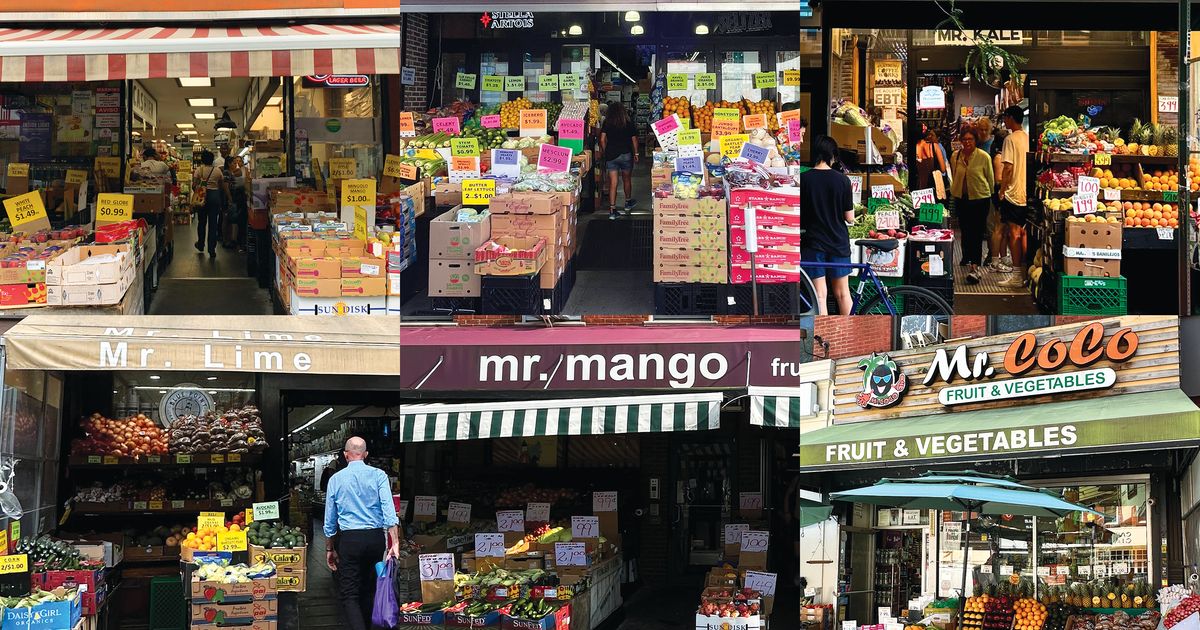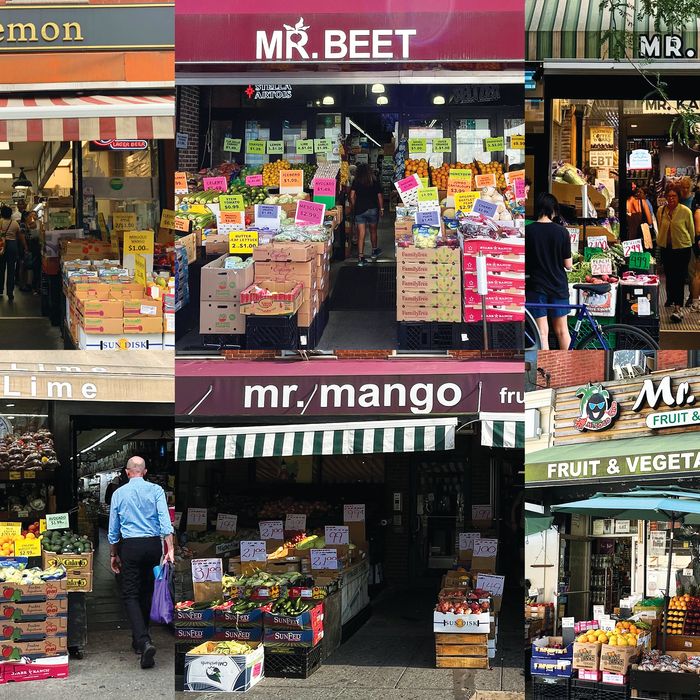How Brooklyn’s popular fruit bodegas came into being


Just a few of the Mr. Fruit stores throughout Brooklyn.
Photo by : Grub Street
A few weeks ago, I received a panicked text from a friend: “Just found out Mr. Piña’s is closing.” They had stopped by the Korean greengrocer in Williamsburg for one of their “three to seven” weekly visits when the cashier broke the news: The building was being sold. “These motherfuckers show no mercy!” they added.
This was no ordinary food crisis. Mr. Piña is part of a chain of stores—which does business as Kipico, Inc., but is called Mr. Fruit by me and everyone I know—that are known locally for their discount fruits and vegetables. But if you live in North Brooklyn, you’re probably already part of Mr. Fruit’s cult.
The stores, 10 of which are scattered across Kings County, are like high-end bodegas, known for their produce but just as often selling a selection of prepared foods, Korean pantry staples and slightly higher-end snacks. Mr. Mango supplies Fort Greene with flowers and two oranges for $1. Mr. Kale is Crown Heights’ main source of bulky Chinese cabbage for $1. Mr. Beet on Smith Street has boxes of dragon fruit hidden across from his refrigerators. Another Mr. Kiwi on Fulton Street recently opened a bibimbap bar for customers who buy cherries ($1.99 a pound) and Annie’s mac ‘n’ cheese (also $1.99).
People are attached to the stores, and the closing of Piña in Williamsburg was a catastrophic event for fans. “It’s heartbreaking because that was the best store,” says Aiyana Leong Knauer, a former regular. “They had cans of this great tuna. They had bags of pretty good coffee. The last time I was there, you know Annas, the Swedish gingerbread cookies? They had” – you guessed it – “on sale.”
The story of Mr. Fruit began at the Myrtle-Broadway subway stop across from another Brooklyn landmark, Big Boy Deli. In 2007, a Korean immigrant in his early 30s named Joon Yoon, who had previously worked at a grocery store in Woodside, opened Mr. Kiwi with his brother Jun. It stands in quiet contrast to the chaos of the intersection, with a full display of produce bulging out front: boxes of cilantro, cartons of mangoes and more. “They had the best selection of stuff, and we could use food stamps to buy fresh juices,” recalls Knauer, who was living in a punk house nearby at the time. “Besides dumpster diving, it was how we sustained ourselves even though we were making almost no money.”
When the number of stores began to grow about ten years ago, Brooklyn residents took notice and many asked themselves: What is this about? Finding good produce at a good price is still something new, even today, for people accustomed to shopping at the city’s shockingly mediocre grocery stores. What secret have the Fruit Brothers discovered that sets their markets apart from the competition?
For starters, the group is now run by five brothers and numerous employees. “Our produce team and I go to Hunts Point Market every morning at 2 a.m. and fight” – metaphorically – “to buy the freshest produce at the best price,” says John Yoo, an operations manager who has been with the company since it was just Mr. Kiwi. At night, the market is a chaotic time as “hundreds” of trucks load and unload, and Yoo gets there early because all the stores have to be stocked by noon. He does this every weekday, which begs the question: When does he sleep? “I get thousands of calls from the stores afterward, so I don’t take a nap,” he says. “I’m awake 24 hours a day.”
In the past, Yoo and other Mr. Fruit emissaries said they benefited from close relationships with vendors at the market. Now, Yoo says, they are using scale to their advantage: “Since we have more than 10 stores, we have purchasing power and can get things a little cheaper than everyone else.”
Another key factor is the actual design of the stores: the products outside, spilled onto the sidewalk, are a bait and switch, designed to lure people into buying the other, (slightly) more expensive products in the store. (Although there are discounts inside too.)
Lauren Ro, who wrote about the deals for Happy Peach in 2016 (and is now a colleague of mine at the Strategist), told me how difficult it was when she had to move away from one of the Mr. Fruits after getting used to having one around: “It was very hard to leave Mr. Coco behind. He was a constant in my life.” Over the years, Ro and Mr. Coco have grown further apart. “I feel guilty because I never stopped by the Mr. Fruits. When I drive around Brooklyn, sometimes I see shops and feel ashamed that I don’t even know if they are real family members or imposters.”
Critics might say that the Mr. Fruit stores are really just stores where neighbors can buy produce at slightly better prices and the same kind of products (probiotic drinks, Harvest Snaps) that you find in other stores in gentrified Brooklyn. That’s true to some extent, but the Mr. Fruits are also just better version of this retail genre. “They really designed it so that when you walk in, everything you need is basically there,” says another fan, Gus McKay. “They seem to have done their homework, and that appealed to me – for some reason I don’t even go to other delis.”
The key, regulars say, is understanding the shopping experience at Mr. Fruit: Take your time perusing the offerings, unless you want moldy berries. And, crucially, don’t show the same patience when it’s time to eat, which will be “immediately.” These berries are discounted for good reason. Some people raise these concerns on Yelp or Google Reviews. For others, it’s part of the deal. Madalyn Summers, a bar manager who lives in the South Slope, says being willing to pivot is crucial when planning dinner: “I walk in there and they have crappy romaine lettuce and wilted containers of Earthbound arugula,” she says. “But I can get a bunch of watercress that looks fresh and delicious.” From there, all she has to do is ask herself: “Do I want to fuck watercress now?”
The flexibility offers freedom: “It’s like a surrender – shopping there means that I open myself up to what Mr. Fruit tells me,” says Knauer. She usually goes out without a plan and bases her meals on what looks good at Mr. Lemon. “I just think to myself: I just take whatever is on offer, whatever is available at a good price..”



